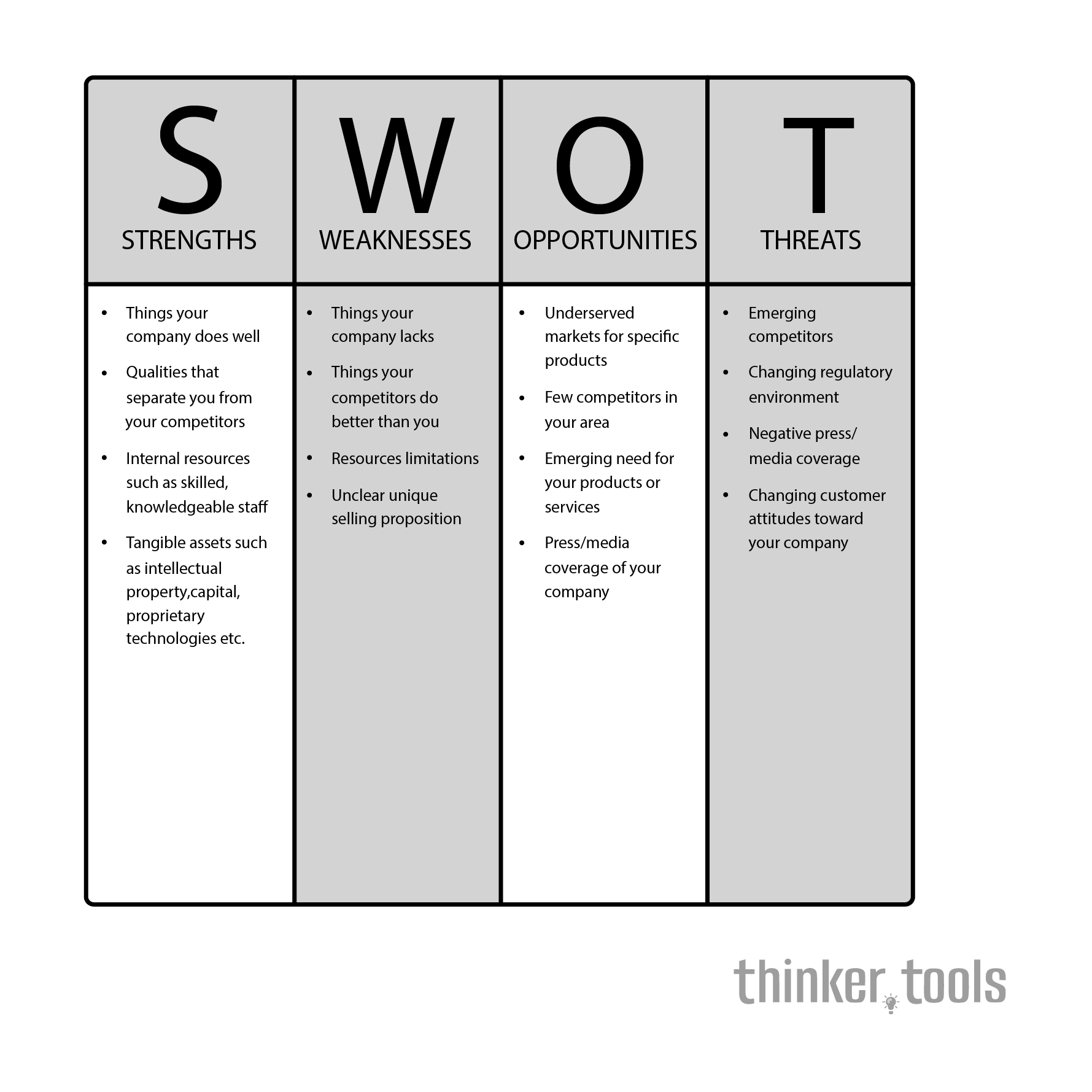
What is SWOT Analysis?
SWOT Analysis is a strategic planning framework that evaluates four key elements: Strengths (internal positives), Weaknesses (internal negatives), Opportunities (external positives), and Threats (external negatives). By systematically examining these four quadrants, SWOT creates a balanced assessment that reveals strategic insights and actionable paths forward.
The Origins and Evolution
SWOT Analysis emerged in the 1960s at Stanford Research Institute, developed by Albert Humphrey and his team during a study of Fortune 500 companies. They sought to understand why corporate planning failed and discovered that successful strategies required balancing internal capabilities with external realities. The framework's elegance and effectiveness led to its rapid adoption across industries, eventually becoming one of the most widely used strategic planning tools in the world.
How to Conduct a SWOT Analysis Step by Step
1. Define Your Focus
Clearly specify what you're analyzing:
- A business or organization
- A product or service
- A project or initiative
- A career or personal situation
- A decision or opportunity
2. Gather Your Team (or Perspectives)
For organizations: Include diverse stakeholders For personal use: Consider different aspects of yourself or seek trusted advisors
3. Analyze Internal Factors
Strengths (Internal Positives) Ask: What do we do well? What unique resources do we have?
- Core competencies and skills
- Valuable assets and resources
- Competitive advantages
- Positive reputation or relationships
- Strong processes or systems
Weaknesses (Internal Negatives) Ask: Where can we improve? What holds us back?
- Skill or resource gaps
- Poor processes or systems
- Negative reputation issues
- Limited resources
- Internal conflicts or inefficiencies
4. Analyze External Factors
Opportunities (External Positives) Ask: What trends favor us? What openings exist?
- Market trends in your favor
- Regulatory changes that benefit you
- Technology developments you can leverage
- Gaps in competition
- Emerging customer needs
Threats (External Negatives) Ask: What external factors could harm us?
- Competitive pressures
- Economic downturns
- Regulatory challenges
- Technology disruptions
- Changing customer preferences
5. Create Your SWOT Matrix
Draw a 2x2 grid and populate each quadrant with bullet points. Keep entries specific and evidence-based rather than vague or wishful.
6. Develop Strategic Actions
Create strategies that:
- Leverage strengths to capture opportunities (SO strategies)
- Overcome weaknesses to capture opportunities (WO strategies)
- Use strengths to defend against threats (ST strategies)
- Minimize weaknesses and avoid threats (WT strategies)
7. Prioritize and Implement
- Rank strategies by impact and feasibility
- Create action plans for top priorities
- Assign responsibilities and timelines
- Monitor progress and adjust
Practical Examples
Small Business SWOT: A local bakery conducts analysis:
- Strengths: Artisan quality, loyal customer base, prime location
- Weaknesses: Limited hours, no online presence, single supplier dependency
- Opportunities: Growing demand for organic options, vacant space next door
- Threats: New chain bakery opening, rising ingredient costs
Strategic Actions: Launch organic line (SO), develop website and delivery (WO), create supplier partnerships (WT)
Career SWOT: A mid-career professional evaluates:
- Strengths: Technical expertise, strong network, multilingual
- Weaknesses: Limited management experience, outdated certifications
- Opportunities: Industry growth, remote work acceptance, mentorship program
- Threats: Automation of current role, younger competition
Strategic Actions: Pursue management training (WO), become thought leader in field (SO), update skills proactively (WT)
Advanced SWOT Techniques
Weighted SWOT: Assign importance scores to each factor for quantitative analysis
SWOT-TOWS Matrix: Systematically combine internal and external factors to generate strategies
Dynamic SWOT: Conduct regular SWOT updates to track changes over time
Competitive SWOT: Analyze competitors using the same framework for comparison
Benefits and Life Impact
SWOT Analysis delivers powerful benefits by:
- Creating clarity from complexity through structured thinking
- Balancing perspectives between internal capabilities and external realities
- Revealing blind spots in both strengths and weaknesses
- Generating strategies that align resources with opportunities
- Building consensus through collaborative analysis
- Enabling proactive planning rather than reactive responses
- Providing a repeatable process for strategic thinking
Whether planning a business strategy, making a career decision, or evaluating any significant choice, SWOT Analysis helps you see the full strategic landscape. It transforms vague feelings about situations into concrete factors you can address. By forcing you to look both inward and outward, SWOT prevents the common mistakes of overconfidence (ignoring weaknesses and threats) or excessive pessimism (overlooking strengths and opportunities). Master this framework, and you'll approach every strategic decision with the balanced perspective needed for success.